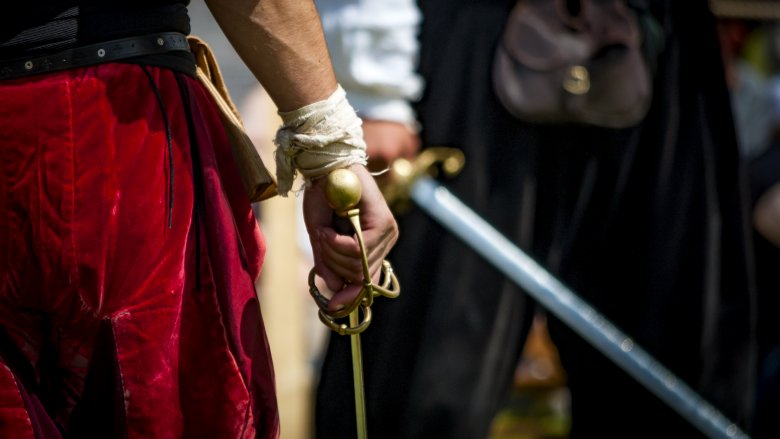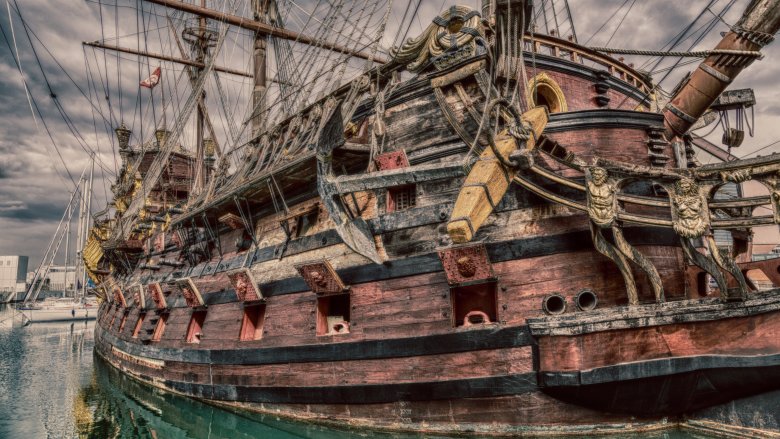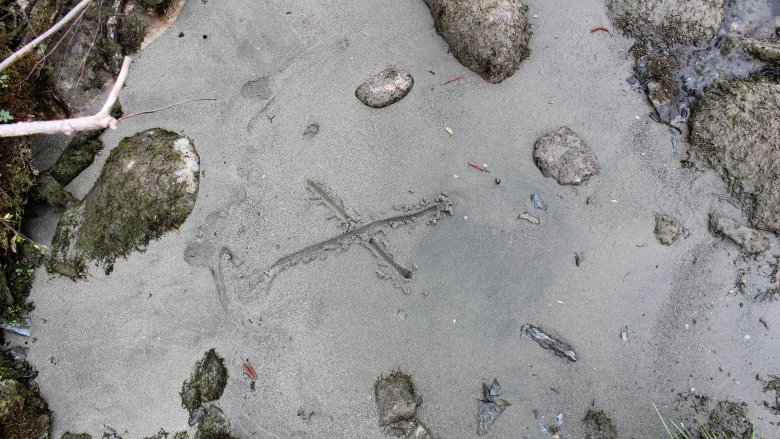What Life Was Actually Like For A Real Pirate
In between bouts of pirate-talk and rocking out to Alestorm (or Lazy Town, whichever you prefer), you may have wondered what life would've been like if you actually were a pirate. As it turns out, your life on the seas would've been drastically different from the one seen in movies like Treasure Island and Pirates of the Caribbean. Here's how your life would've truly gone, ye scurvy dog.
You were truly brutal and ruthless
When you think of pirate brutality, you probably run with sword fights, plank-walking, and the Boo Box. But the truth is, if you wanted to be a successful pirate, you needed to be brutal, ruthless, merciless, and violent beyond even the goriest of horror films.
According to National Geographic , stunts like "walk the plank" almost never happened, if at all. As Cori Convertito, assistant curator of education at Key West's Mel Fisher Maritime Museum explained, actual pirates much preferred something called "keel hauling," where they'd tie a prisoner to the ship, throw them overboard, and set sail as the victim was dragged along through the water. They would either drown or get battered to death by the boat itself — if Captain Hook had thought about that, Peter Pan probably would've been finished long ago.
That's just the start, though — the famed pirate Blackbeard was known for hacking off women's fingers if they wouldn't give up their rings. Instead of thin, elegant swords, most pirates would prefer to go after each other with axes and thick cutlasses, hacking at their opponents like they were trees. And if you really irked them, prepare to pay painfully — one story speaks of a pirate trying to get information about nearby treasure from a couple captives. He tortured them by tying each to a tree. He then carved out one of their hearts, and forced the other victim to eat it. If Johnny Depp wants to add a little something to his character for Pirates 6, here's a fine start.
You didn't say ARRRRRRRR
Even the most casual pirate aficionado knows to growl ARRRRRRR after basically every sentence. It's the universal pirate lingo ... despite it being entirely a Hollywood invention. The number of actual pirates who growled ARRRRRRR is almost certainly zero.
As Slate explained, ARRRRRRR wasn't a pirate thing until a 1934 movie, while a few years later, a 1940 novel had one of its pirate characters exclaim it for fictional purposes. Those instances, plus the exaggerated, rolling R's that 1950s actor Robert Newton used when portraying Long John Silver in movies and TV, convinced the masses that all pirates spoke with a West Country English accent and growled ARRRRRR at all times.
In reality, pirates not only didn't growl that, they didn't even talk like "pirates." Pirates came from all over the world, and — just like us today — that means all sorts of different dialects, accents, slang, and languages littered the Seven Seas. If they had a favorite letter of the alphabet, it probably wasn't R. And they'd probably keel haul you for implying it was.
You probably wore an eyepatch, but for practical purposes
No pirate costume is complete without an eyepatch. It shows that you're hardcore and been through some stuff, like a hook to the eyeball. And unlike some other pirate stereotypes, there's actually truth to this one. Many pirates did indeed wear eyepatches, but they didn't do so for fashion's sake, or to hide a terrible wound. They actually had far more mundane, practical motives, like navigating in the dark.
As Heidi Mitchell of the Wall Street Journal points out (in an article republished by Vision Source), the human eye has difficulty adjusting to sudden darkness. In fact, if you suddenly go from the brightest of sunny days to the darkest of dank caves or ship cellars, your eyes may take up to 25 minutes to adjust. And when angry, bloodthirsty pirates are on your tail, you can't afford even 25 seconds for your vision to warm up, let alone 25 minutes.
A smart pirate would wear a patch over one eye, so it was constantly adjusted to darkness. If Soggybottom Jack found himself in pitch black and needed good vision fast, all he'd need to do is switch the patch to the other eye. That way, one eye's immediately ready to fight in the dark, while the other doesn't need to readjust at all.
In a way, an eyepatch is the best of both worlds. It's cool looking, shows that you're tough as nails, and that you're dreadfully smart to boot. No smart pirate would dare tangle with one possessing such a total package.
Your ship was uncomfortable and disgusting
Don't think for a second you would have been comfortable on your ship. Movies and TV portray the pirate life as one big party, which was kinda true, except the party was run by the worst, most disorganized, most disgusting frat ever. Yes, life on a pirate ship was shockingly terrible.
David Moore, curator of nautical archaeology at Beaufort, North Carolina's Maritime Museum, told National Geographic that pirate ships had basically nothing in the way of comforts or luxuries. There were no fans, no ice, no toilets, no refrigeration — basically nothing that would make life comfortable in any way. You were stuck on a creaky, crowded ship, with nothing to make you smile — except, that is, the prospect of actually leaving the ship someday.
The problems grew worse with food and drink. As Smithsonian Magazine pointed out, the lack of refrigeration meant food like meat and vegetables would spoil extremely fast. Beans and flour could rapidly get moldy too, because ship conditions were perpetually wet. And even storing fresh water was hard, due to the possibility of algae scum forming in it.
Their only solution most of the time was to eat terrible food like hardtack: super-hard, dry bread that was barely edible and had weevils crawling in it half the time. As for their liquid solution: they just got stinking drunk off of rum. Alcohol didn't spoil, so they typically drank that in place of water. They weren't getting drunk because "yo ho ho it's a pirate's life for them" — they did it because it was either that or death from dehydration.
You plundered way more than just gold and treasure
When fictional pirates go a-plundering, it's almost always for gold, jewelry, or some other form of priceless, shiny treasure. After all, once you've sailed hundreds of miles to find something worth keeping, why not settle only for the absolute best? Real-life pirates would agree with you, except their version of "the absolute best" wasn't often gold and jewelry, but rather mundane stuff, like what you'd put on your grocery list.
According to the book Real Pirates: The Untold Story of the Whydah from Slave Ship to Pirate Ship, pirates needed to plunder simply to survive from day to day. So while they certainly wouldn't say no to priceless treasure (they may have been crazy to spend their lives on the high seas, but they weren't stupid), more often their preferred prizes were more practical, everyday items like soap, candles, or utensils — anything that could help turn pirate life into something more than "float around aimlessly until bacteria or a sword sent you to Kingdom Come."
As put in David Cordingly's book Under the Black Flag: the Romance and the Reality of Life Among the Pirates (and recapped on Cindy Valler's "Pirates and Privateers" site), Captain Kidd raided a ship in 1698 with silver and gold in tow. More importantly, though, Kidd went for goods like silk, sugar, iron, cotton, and (most important of all) cocoa. Even the famous Captain Kidd understood that if you only looted money, you wouldn't have time to spend it, because you'd likely be crocodile chow in record time.
You didn't bury your treasure, but spent it fast
Don't think all this talk of sugar and silk being a pirate's preferred treasure means they rejected riches. On the contrary, if they found gold, silver, or anything else valuable, they took all they could carry. But all this talk of buried treasure hidden here and there is almost complete bunk. And the idea of treasure maps promising gold if you just follow the X? That's actual complete bunk.
As National Geographic explained, if you were a pirate and came across gold or silver, you spent every last penny (or whatever they used for pennies back then) as quickly as you could. You went to popular pirate hangouts — like Port Royal or Tortuga — and bought up all the goods, food, alcohol, and women you could afford.
If you think about it, this was the only way to survive as a pirate. The scurvy sea-outlaw life carried the risk of death behind every wave, so it made absolutely no sense to bury your booty and go back for it later. Chances were good there'd likely be no later. And if you didn't use your money to buy what you needed to survive, there'd definitely be no later.
So now you know — if some shyster tries to sell you a map to Blackbeard's lost treasure, walk away, because it's a scam. If you truly want to track down Blackbeard's money, go to Port Royal and find wherever they keep the booze. You're now as close as you'll ever get.
Piracy was a regular, organized job, complete with workman's comp
We tend to think of piracy as not so much a career, but just a thing pirates did until they died. But there's ample evidence that for many people, piracy was a legitimate career, albeit one with far less paperwork than yours.
According to Peter Leeson's book The Invisible Hook: The Hidden Economics of Pirates, a typical pirate ship was surprisingly organized — at least as far as its employee structure went. Their captains were voted on like we might vote for president, and they also worked together to delegate responsibilities among the other crew members. To provide incentive for everybody to do their job, each pirate basically became an equal partner in the ship, and could receive bonuses based on their performances and how much they contributed to the latest violent raid. What's more, many ships even included a workman's comp program — that way, if you wound up hurt enough that you'd legitimately need a peg leg, you'd be taken care of financially and could afford the good wood.
The idea that once a pirate outlived their usefulness he was tossed to the crocodiles is either pure fantasy, or a sign that the captain was cruel and wouldn't last long. Remember, these captains were voted in and could be voted out just as easily. If they lost their job because they were cruel, the other pirates would be murderously unkind to him in retirement. After all, they may have been organized work-a-day Joes just trying to do their jobs, but they were still pirates.
You probably had a pet (and it might've been a parrot)
Some pirate stereotypes are true, like the parrot thing. While not every captain came equipped with a squawking bird on his shoulder, a good chunk of them did, but not purely for aesthetic, look-at-me-I'm-a-pirate reasons. Like everything else a real pirate did, owning a parrot was more practical than anything else.
The scoop comes from Colin Woodard, author of the epically-titled The Republic of Pirates: Being the True and Surprising Story of the Caribbean Pirates and the Man Who Brought Them Down (being a true and surprising story quoted by Atlas Obscura). According to Woodard, the typical pirate treasure hunt was long and, until you got to looting, incredibly dull and boring. So lots of pirates embraced the idea of a pet to keep them company during the long stretches of just sailing. The issue was finding the right pet. It couldn't be too large — a big animal around a crowded vessel simply wouldn't do. It also needed to be good around the water, and it needed minimal food, because the pirates much preferred eating the food themselves.
Dogs were out of the question, as they were more of a aristocratic thing at the time. Cats were okay, because they were small and could catch mice, but good luck getting the typical cat anywhere near a wet ship surrounded by water. Plus, pirates were exotic and wanted cool, exotic pets too.
Some delightfully went with pet monkeys, but most preferred parrots. They didn't eat a lot, you could easily store what they did eat, you could talk to them, and when you got sick of them (or simply needed the money), they fetched a pretty penny on the black market.
That's right, in addition to everything else you're learning today, now you know there was once a black market parrot trade — and that there still is one today.
You likely dressed like any other sailor of the time
You know the typical pirate costume — big hat or bandana, long jacket, a big belt buckle, shirts with strings around the collar instead of buttons, and maybe some pants torn at the knees to show you've really been through some rough-and-tough pirate business. This, as it turns out, is, mostly bogus. Pirates didn't universally talk the same, and they sure didn't dress the same either.
According to the book Pirate: the Golden Age by Angus Konstam and David Rickman, we don't actually have much evidence for how the typical pirate dressed. They reference the book A General History of the Robberies and Murders of the Most Notorious Pyrates by Captain Charles Johnson (who could captain a ship but apparently not spell) when explaining that eyewitness accounts and first-hand descriptions of pirates were exceptionally rare. After all, most people who saw them up close didn't survive the meeting. Thus, stories of what pirates, and even their captains, looked like and how they dressed vary from person to person. You may have enjoyed playing Telephone as a kid, but people writing about pirates perfected it.
So we're left with common sense. And common sense tells us that there's no reason to assume various groups of people from all corners of the world magically all dressed the same. More likely, they dressed like typical maritime sailors, a style that likely varied from place to place. Witness accounts at the trial of notorious female pirates Anne Bonny and Mary Read said they dressed in men's jackets with baggy trousers — exactly how every other sailor at the time dressed.
So if you want an accurate pirate costume, research what legitimate sailors of the 1700s wore, and copy that. Then prepare for everyone at the costume party to get confused when you show up and say you're a pirate. Alas.
You might have been working for the government
To many of us, the appeal of being a pirate is that you're an outlaw. You have no bosses, no CEOs, no shareholders — as long as you keep plundering, you can get as rich as you want. It's like freelancing, except with significantly more scurvy and stabbing.
But if a pirate was good enough at their job, legitimate and supposedly law-abiding governments might actually hire them to do their dirty work. According to the New York Times, over the course of the "Golden Age" of piracy — a period around the 1600s and 1700s where no sailor was safe from murderous, looting pirates — pirates had become scary good at what they did. So, in a case of "if you can't beat 'em, make 'em join you," some governments would actually hire these career criminals as privateers, charging them with ransacking other nations, attacking enemy ships ... basically, they were now legal hitmen.
Captain Henry Morgan (yes, the rum guy) was a particularly excellent privateer, attacking Spanish posts throughout the Americas and becoming one of the New World's first truly feared characters. You know you're good at being bad when the most impressive bad stuff you did was at the paid behest of the government.









